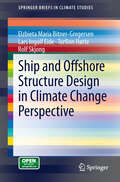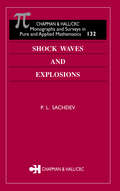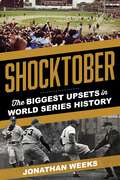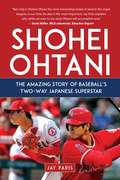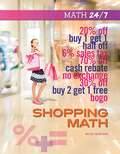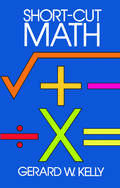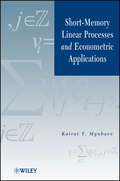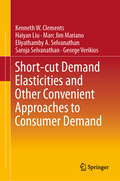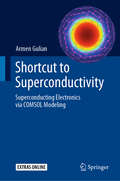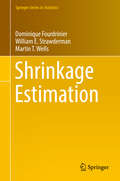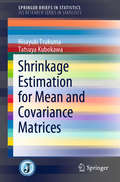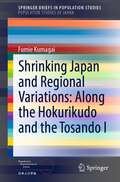- Table View
- List View
Shimura Varieties (London Mathematical Society Lecture Note Series #457)
by Michael Harris Thomas HainesThis is the second volume of a series of mainly expository articles on the arithmetic theory of automorphic forms. It forms a sequel to On the Stabilization of the Trace Formula published in 2011. The books are intended primarily for two groups of readers: those interested in the structure of automorphic forms on reductive groups over number fields, and specifically in qualitative information on multiplicities of automorphic representations; and those interested in the classification of I-adic representations of Galois groups of number fields. Langlands' conjectures elaborate on the notion that these two problems overlap considerably. These volumes present convincing evidence supporting this, clearly and succinctly enough that readers can pass with minimal effort between the two points of view. Over a decade's worth of progress toward the stabilization of the Arthur-Selberg trace formula, culminating in Ngo Bau Chau's proof of the Fundamental Lemma, makes this series timely.
Ship and Offshore Structure Design in Climate Change Perspective (SpringerBriefs in Climate Studies)
by Rolf Skjong Elzbieta Maria Bitner-Gregersen Tor Svensen Lars Ingolf Eide Torfinn HørteThis book summarizes results of longstanding research and scientific contributions from many projects and relevant working groups. It collects and evaluates wind and wave climate projections under changing climate having design needs and marine safety in focus. Potential impact of projected climate change in met-ocean conditions on ships and offshore structures is discussed and illustrated by an example of the expected wave climate change on tanker design. The monograph is intended for students, researchers and industry based engineers who want a summary of the many studies that have been carried out on climate change effects on wind and waves and their importance for design and operations of ship and offshore structures. The reader needs only a moderate knowledge of marine wind and wave climate to follow the text.
Shock Phenomena in Granular and Porous Materials (Shock Wave and High Pressure Phenomena)
by Tracy J. Vogler D. Anthony FredenburgGranular forms of common materials such as metals and ceramics, sands and soils, porous energetic materials (explosives, reactive mixtures), and foams exhibit interesting behaviors due to their heterogeneity and critical length scale, typically commensurate with the grain or pore size. Under extreme conditions of impact, granular and porous materials display highly localized phenomena such as fracture, inelastic deformation, and the closure of voids, which in turn strongly influence the bulk response. Due to the complex nature of these interactions and the short time scales involved, computational methods have proven to be powerful tools to investigate these phenomena. Thus, the coupled use of experiment, theory, and simulation is critical to advancing our understanding of shock processes in initially porous and granular materials. This is a comprehensive volume on granular and porous materials for researchers working in the area of shock and impact physics. The book is divided into three sections, where the first presents the fundamentals of shock physics as it pertains to the equation of state, compaction, and strength properties of porous materials. Building on these fundamentals, the next section examines several applications where dynamic processes involving initially porous materials are prevalent, focusing on the areas of penetration, planetary impact, and reactive munitions. The final section provides a look at emerging areas in the field, where the expansion of experimental and computational capabilities are opening the door for new opportunities in the areas of advanced light sources, molecular dynamics modeling, and additively manufactured porous structures. By intermixing experiment, theory, and simulation throughout, this book serves as an excellent, up-to-date desk reference for those in the field of shock compression science of porous and granular materials.
Shock Waves & Explosions (Monographs and Surveys in Pure and Applied Mathematics)
by P.L. SachdevUnderstanding the causes and effects of explosions is important to experts in a broad range of disciplines, including the military, industrial and environmental research, aeronautic engineering, and applied mathematics. Offering an introductory review of historic research, Shock Waves and Explosions brings analytic and computational methods
Shocktober: The Biggest Upsets in World Series History
by Jonathan WeeksBaseball&’s October showcase has provided some high drama over the years. Willie Mays&’s spectacular catch in 1954, Bill Mazeroski&’s walk-off homer in 1960, and Kirk Gibson&’s pinch-hit blast in 1988 are just a few of the memorable moments that have dominated highlight reels. The outcome of the Series has not always been terribly surprising—especially during the late 1940s and early 1950s when the Yankees captured five consecutive championships, breaking their previous record of four straight titles from 1936 to 1939. But in spite of its predictability at times, the Fall Classic has taken many unexpected turns. The 1906 Cubs lost to the weak-hitting White Sox after establishing a new regular season record for wins. The 1955 Dodgers avenged seven prior October failures with an improbable victory over the seemingly invincible Yankees. And in 1969, the Mets finally shed their image as &“loveable losers,&” dethroning the powerful Orioles. In more than a century of World Series plays, a number of similar scenarios have emerged. Twenty-two of those stories are told in Shocktober. The book also includes an appendix of game statistics as well as a section on World Series trivia.
Shohei Ohtani: The Amazing Story of Baseball's Two-Way Japanese Superstar
by Jay ParisRarely does anyone use the term “two-way” in regard to a baseball player. Yet the Los Angeles Angels’ Shohei Ohtani, at the young age of twenty-three, has become the epitome of the term, drawing comparisons to Babe Ruth by baseball pundits everywhere. After being drafted by the Hokkaido Nippon-Ham Fighters of the Japan Pacific League with the number-one pick in 2012, the eighteen-year-old Ohtani struggled with the bat during his rookie season. However, he had a breakout year in 2014, posting a 2.61 ERA in 24 starts and 179 strikeouts (as well as 10 home runs). By 2017, all thirty Major League Baseball teams had heard about the Japanese phenom and expressed interest in signing him. Ultimately, the Angels offered him the opportunity to compete as a two-way player and the chance to accomplish his professional goals. After a quiet spring training, Ohtani broke out in the first two weeks of the 2018 regular season, becoming just the 14th pitcher in major-league history to strike out 12 batters in one of his first two starts. He also homered in three consecutive games during that stretch. Shohei Ohtani: The Amazing Story of Baseball’s Two-Way Japanese Superstar tells the story of the player from rural Japan who became a two-way star not seen in America since Babe Ruth. With highlights of his best games on the mound and at bat from each month of his rookie season and anecdotes of his life in America, this is the one book that every fan will want.
Shopping Math (Math 24/7 #10)
by Helen ThompsonWhen you see a sign in your favorite store saying that everything is 30% off, can you do the math to figure out what that means? Are you good at keeping track of how much things cost--while remembering how much money you actually have in your wallet? What about sales tax? Do you remember to add that on to your total costs when you're deciding if you have enough money to buy a pair of jeans? Shopping Math can help you do all this and more!
Short-Cut Math (Dover Books on Mathematics)
by Gerard W. KellyCan you multiply 362 x .5 quickly in your head? Could you readily calculate the square of 41? How much is 635 divided by 2½? Can 727,648 be evenly divided by 8? If any of these questions took you more than a few seconds to solve, you need this book. Short-Cut Math is a concise, remarkably clear compendium of about 150 math short-cuts -- timesaving tricks that provide faster, easier ways to add, subtract, multiply, and divide.By using the simple foolproof methods in this volume, you can double or triple your calculation speed -- even if you always hated math in school. Here's a sampling of the amazingly effective techniques you will learn in minutes: Adding by 10 Groups; No-Carry Addition; Subtraction Without Borrowing; Multiplying by Aliquot Parts; Test for Divisibility by Odd and Even Numbers; Simplifying Dividends and Divisors; Fastest Way to Add or Subtract Any Pair of Fractions; Multiplying and Dividing with Mixed Numbers, and more.The short-cuts in this book require no special math ability. If you can do ordinary arithmetic, you will have no trouble with these methods. There are no complicated formulas or unfamiliar jargon -- no long drills or exercises. For each problem, the author provides an explanation of the method and a step-by-step solution. Then the short-cut is applied, with a proof and an explanation of why it works.Students, teachers, businesspeople, accountants, bank tellers, check-out clerks -- anyone who uses numbers and wishes to increase his or her speed and arithmetical agility, can benefit from the clear, easy-to-follow techniques given here.
Short-Memory Linear Processes and Econometric Applications
by Kairat T. MynbaevThis book serves as a comprehensive source of asymptotic results for econometric models with deterministic exogenous regressors. Such regressors include linear (more generally, piece-wise polynomial) trends, seasonally oscillating functions, and slowly varying functions including logarithmic trends, as well as some specifications of spatial matrices in the theory of spatial models. The book begins with central limit theorems (CLTs) for weighted sums of short memory linear processes. This part contains the analysis of certain operators in Lp spaces and their employment in the derivation of CLTs. The applications of CLTs are to the asymptotic distribution of various estimators for several econometric models. Among the models discussed are static linear models with slowly varying regressors, spatial models, time series autoregressions, and two nonlinear models (binary logit model and nonlinear model whose linearization contains slowly varying regressors). The estimation procedures include ordinary and nonlinear least squares, maximum likelihood, and method of moments. Additional topical coverage includes an introduction to operators, probabilities, and linear models; Lp-approximable sequences of vectors; convergence of linear and quadratic forms; regressions with slowly varying regressors; spatial models; convergence; nonlinear models; and tools for vector autoregressions.
Short-cut Demand Elasticities and Other Convenient Approaches to Consumer Demand
by Kenneth W. Clements Haiyan Liu Eliyathamby A. Selvanathan Saroja Selvanathan Marc Jim Mariano George VerikiosThis book provides answers to analysts&’ need to know about elasticities of demand, with a unique two-track approach. The first gives a self-contained, non-technical rendition, accessible to those with limited background. The second track contains the underlying theory, derivations, and some more advanced material. Subsequent chapters deal with the demand for food and other groups of goods, the system-wide approach, and the demand side of EDM and CGE models. This convenient source book will be valuable to students, consultants, business economists and government policy analysts. Clarity of exposition and economic intuition is emphasised throughout. &“In this remarkable book, the authors bridge the gap between sophisticated consumer demand theory and the practical world of economic modeling. Their guidance will be invaluable to anyone aiming to shed light on the economic impact of public policies.&” Thomas W. Hertel, Distinguished Professor and Executive Director, Center for Global Trade Analysis, Purdue University &“The elasticity of demand is a key parameter in economics - whether for micro studies or large-scale models. This book illuminates on short-cut approaches for measuring this elasticity and provides derivations and applications. It is a valuable resource for both students and seasoned economists.&” Paul Burke, Professor and Head, Arndt-Corden Department of Economics and Deputy Director, Crawford School of Public Policy, ANU College of Law, Governance and Policy, Australian National University &“This book endears itself to me with its honest approach to determining elasticities for use in policy analysis. In Chapter 1
Shortcut to Superconductivity: Superconducting Electronics via COMSOL Modeling
by Armen GulianThis accessible textbook offers a novel, concept-led approach to superconducting electronics, using the COMSOL Multiphysics software to help describe fundamental principles in an intuitive manner.Based on a course taught by the author and aimed primarily at engineering students, the book explains concepts effectively and efficiently, uncovering the “shortcut” to understanding each topic, enabling readers to quickly grasp the underlying essence. The book is divided into two main parts; the first part provides a general introduction to key topics encountered in superconductivity, illustrated using COMSOL simulations based on time-dependent Ginzburg-Landau equations and avoiding any deeply mathematical derivations. It includes numerous worked examples and problem sets with tips and solutions.The second part of the book is more conventional in nature, providing detailed derivations of the basic equations from first principles. This part covers more advanced topics, including the BCS-Gor'kov-Eliashberg approach to equilibrium properties of superconductors, the derivation of kinetic equations for nonequilibrium superconductors, and the derivation of time-dependent Ginzburg–Landau equations, used as the basis for COMSOL modeling in the first part.Supported throughout by an extensive library of COMSOL Multiphysics animations, the book serves as a uniquely accessible introduction to the field for engineers and others with a less rigorous background in physics and mathematics. However, it also features more detailed mathematical background for those wishing to delve further into the subject.
Show and Tell! Great Graphs and Smart Charts: An Introduction to Infographics
by Stuart J. MurphyA visual-learning expert races up the charts and graphs math success with kid-friendly content sure to help with homework.Want to find the most popular meal in the cafeteria? Compare town sports enrollments? Or maybe you just want to know who burps the most in your family! Learn what line graphs, bar graphs, pie charts, and pictographs are and how and when to use them to represent data. Each project shows how to build a chart or graph and ties it all together with a creative infographic that really puts the A in STEAM (Science, Technology, Engineering, ARTS, and Mathematics). Whether used as an introductory aid or to underscore previous knowledge, the book prepares today's visually savvy children to succeed in school and life by analyzing the world around them.
Shrinkage Estimation (Springer Series in Statistics)
by Dominique Fourdrinier William E. Strawderman Martin T. WellsThis book provides a coherent framework for understanding shrinkage estimation in statistics. The term refers to modifying a classical estimator by moving it closer to a target which could be known a priori or arise from a model. The goal is to construct estimators with improved statistical properties. The book focuses primarily on point and loss estimation of the mean vector of multivariate normal and spherically symmetric distributions. Chapter 1 reviews the statistical and decision theoretic terminology and results that will be used throughout the book. Chapter 2 is concerned with estimating the mean vector of a multivariate normal distribution under quadratic loss from a frequentist perspective. In Chapter 3 the authors take a Bayesian view of shrinkage estimation in the normal setting. Chapter 4 introduces the general classes of spherically and elliptically symmetric distributions. Point and loss estimation for these broad classes are studied in subsequent chapters. In particular, Chapter 5 extends many of the results from Chapters 2 and 3 to spherically and elliptically symmetric distributions. Chapter 6 considers the general linear model with spherically symmetric error distributions when a residual vector is available. Chapter 7 then considers the problem of estimating a location vector which is constrained to lie in a convex set. Much of the chapter is devoted to one of two types of constraint sets, balls and polyhedral cones. In Chapter 8 the authors focus on loss estimation and data-dependent evidence reports. Appendices cover a number of technical topics including weakly differentiable functions; examples where Stein’s identity doesn’t hold; Stein’s lemma and Stokes’ theorem for smooth boundaries; harmonic, superharmonic and subharmonic functions; and modified Bessel functions.
Shrinkage Estimation for Mean and Covariance Matrices (SpringerBriefs in Statistics)
by Hisayuki Tsukuma Tatsuya KubokawaThis book provides a self-contained introduction to shrinkage estimation for matrix-variate normal distribution models. More specifically, it presents recent techniques and results in estimation of mean and covariance matrices with a high-dimensional setting that implies singularity of the sample covariance matrix. Such high-dimensional models can be analyzed by using the same arguments as for low-dimensional models, thus yielding a unified approach to both high- and low-dimensional shrinkage estimations. The unified shrinkage approach not only integrates modern and classical shrinkage estimation, but is also required for further development of the field. Beginning with the notion of decision-theoretic estimation, this book explains matrix theory, group invariance, and other mathematical tools for finding better estimators. It also includes examples of shrinkage estimators for improving standard estimators, such as least squares, maximum likelihood, and minimum risk invariant estimators, and discusses the historical background and related topics in decision-theoretic estimation of parameter matrices. This book is useful for researchers and graduate students in various fields requiring data analysis skills as well as in mathematical statistics.
Shrinking Japan and Regional Variations: Along the Hokurikudo and the Tosando I (SpringerBriefs in Population Studies)
by Fumie KumagaiThis book provides an insightful sociological study of the shrinking Japanese population through a regional variation perspective as it varies significantly by municipality, even within the same prefecture. Using demographic data on municipal levels, the book identifies the power unique to each municipality, which can mobilize a shrinking but sustainable Japan. The study identifies the principal explanatory factors based on the small area data of e-Stat through GPS statistical software tools such as G-census and EvaCva within a historical perspective. The theoretical framework of this study, i.e., the reason for regional variations in Japan, is the Goki-Shichido (Five Home Provinces and Seven Circuits of Ancient Japan). This historical knowledge helps in understanding the significance of the regional cultural heritage that remains in each municipality today. The book pays special attention to municipal variations within the same prefecture, utilizing a completely unique approach, unlike those that have been pursued by other researchers. This volume studies two present-day prefectures for detailed analyses based on the Goki-Shichido framework for impacts of regional variations of population decline in Japan. They are Niigata Prefecture, made up of the formerly named Echigo and Sado provinces; Ishikawa Prefecture, formed by the ancient Kaga and Noto provinces; Fukui Prefecture, based on the earlier Wakasa and Echizen provinces of the Hokurikudo; Nagano Prefecture, still called Shinano Province today and commonly divided into four areas and ten regions; and Gifu Prefecture, composed of the ancient Mino and Hida provinces of the Tosando as examples of the impact of municipal power on regional variations of shrinking Japan. However, due to the limitation of the number of pages set forth for Springer Briefs in Population Studies: Population Studies of Japan, for which the current publication is a part, it has become necessary to divide the book into two volumes, namely Volume I and Volume II. Because of this limitation the current volume I is consisted of three chapters, namely, Chapter 1: Issues, theoretical framework, and methodology; Chapter 2: Niigata Prefecture in the Hokurikudo; and Chapter 3: Ishikawa Prefecture in the Hokurikudo. The remaining three prefectures, i.e., Fukui in the Hokurikudo area, Nagano and Gifu both in the Tosando area will be discussed in the Volume II of this book. By presenting unique analyses of regional variations on small municipal levels, with demographic variables, social indicators, and historical identities, this book offers suggestions for effective regional policies to revitalize a shrinking Japan to a sustainable one. The Volume I, therefore, analyzes and discusses in detail both Niigata and Ishikawa prefectures of the Hokurikudo.
Shrinking Japan and Regional Variations: Along the Hokurikudo and the Tosando II (SpringerBriefs in Population Studies)
by Fumie KumagaiThis book provides an insightful sociological study of the shrinking Japanese population through a regional variation perspective as it varies significantly by municipality, even within the same prefecture. Using demographic data on municipal levels, the book identifies the power unique to each municipality, which can mobilize a shrinking but sustainable Japan. The study identifies the principal explanatory factors based on the small area data of e-Stat through GPS statistical software tools such as G-census and EvaCva within a historical perspective. The theoretical framework of this study, i.e., the reason for regional variations in Japan, is the Goki-Shichido (Five Home Provinces and Seven Circuits of Ancient Japan). This historical knowledge helps in understanding the significance of the regional cultural heritage that remains in each municipality today. The book pays special attention to municipal variations within the same prefecture, utilizing a completely unique approach, unlike those that have been pursued by other researchers. This book studies three present-day prefectures for detailed analyses based on the Goki-Shichido framework for impacts of regional variations of population decline in Japan. They are Niigata Prefecture, made up of the formerly named Echigo and Sado provinces; Ishikawa Prefecture, formed by the ancient Kaga and Noto provinces; Fukui Prefecture, based on the earlier Wakasa and Echizen provinces of the Hokurikudo; Nagano Prefecture, still called Shinano province today and commonly divided into four areas and ten regions; and Gifu Prefecture, composed of the ancient Mino and Hida provinces of the Tosando as examples of the impact of municipal power on regional variations of shrinking Japan. However, due to the limitation of the number of pages set forth for Springer Briefs in Population Studies: Population Studies of Japan, for which the current publication is a part, it has become necessary to divide the book into two volumes, namely Volume I and Volume II. Because of this limitation, the current Volume II consisted of four chapters. They are Chapter 1: Fukui Prefecture in the Hokurikudo; Chapter 2: Nagano Prefecture in the Tosando; Chapter 3: Gifu Prefecture in the Tosando, and Chapter 4: Epilogue: The Future of Shrinking Japan. The remaining two prefectures, i.e., Niigata and Ishikawa prefectures in the Hokurikudo area have been discussed in the Volume I of this book. By presenting unique analyses of regional variations on small municipal levels, with demographic variables, social indicators, and historical identities, this book offers suggestions for effective regional policies to revitalize a shrinking Japan to a sustainable one.
Shrinking Japan and Regional Variations: Along the Sannyodo (SpringerBriefs in Population Studies)
by Fumie KumagaiTaking the Goki-Shichido (Five Home Provinces and Seven Circuits of Ancient Japan) as a theoretical framework, this book examines shrinking Japan from a regional variation perspective by municipality along the ancient Sannyodo, which comprises eight provinces and four prefectures today. The book identifies the principal explanatory factors based on the small area data of e-Stat through GPS statistical software tools such as G-census and EvaCva, within a historical perspective. This historical knowledge helps in understanding the significance of the regional cultural heritage that remains in each municipality today. The book pays special attention to municipal variations within the same prefecture, presenting a completely unique approach from what other researchers have pursued.This book studies two present-day prefectures along the ancient Sannyodo for detailed analyses of the impacts of regional variations of population decline in Japan. They are Hiroshima Prefecture, made up of the former Bingo and Aki provinces, and Yamaguchi Prefecture, formed by the ancient provinces of Suo and Nagato. The reasons for selecting these two prefectures of ancient Sannyodo are twofold. First, they are made up of a multiple number of the ancient provinces. Second, other prefectures that fall under the Sannyodo have been studied in the previous works of the present author by adopting the same methods of analyses. Thus, by presenting unique analyses of regional variations on small municipal levels in Hiroshima and Yamaguchi prefectures along the Sannyodo, this book offers suggestions for effective regional policy to revitalize shrinking Japan to a sustainable one.
Si, Dios es un Matematico
by Luis Rentería Ruiz Dhanesh Kumar MCreemos que Dios nunca puede ser entendido por la ciencia que exige pruebas. Desde el comienzo de los tiempos, muchos han buscado las respuestas a los misterios más grandes del mundo. Quizás el misterio más antiguo de la humanidad es "¿Cuál es la relación entre Dios y el hombre / la mujer?" Sorprendentemente, la respuesta puede estar en un modelo matemático oculto dentro de la arquitectura antigua de la India, que se cree que tiene al menos cinco mil años de antigüedad. Si puedes dedicar un par de horas a una lectura entretenida, puedes ver a Dios en el lente de la ciencia. Los devotos de todo el mundo pueden asombrarse y quizás hasta ofenderse ante la idea de que podemos buscar al Ser Divino Supremo, Dios, a través del campo rico y texturizado de las Matemáticas. Pero con un poco de paciencia, y casi sin querer, puedes aprender de una rama de las Matemáticas, entrelazada con los asombrosos mitos y leyendas de la India. Estas matemáticas no son complejas. Un alumno de secundaria puede entenderlas. Sin embargo, el producto de desarrollo es más completo que el algoritmo moderno más complejo. Para su placer de lectura, las matemáticas que respaldan este modelo se explican de una manera placentera y sin dolor, junto con una historia en el aula de clases. Cuando leemos este libro, nos sorprende ver que tales tesoros arquitectónicos son realmente los prototipos de la Divinidad. Esto demuestra cómo este modelo matemático, en esencia, se ha proyectado a sí mismo como un microcosmos del mundo real. Se imita la teoría de la Creación y Realidad como se describe en las doctrinas hindúes. Ven a disfrutar de una historia de las matemáticas, entrelazada con los asombrosos mitos y leyendas de la India. Vamos, entra en la antigua ciencia india de la Creación arquitectónica, que es un mundo lleno de curiosidades y maravillas.
Sich selbst diagnostizieren und fördern mit digitalen Medien: Forschungsbasierte Entwicklung eines Tools zum formativen Selbst-Assessment funktionalen Denkens (Essener Beiträge zur Mathematikdidaktik)
by Hana RuchniewiczFormative Selbstdiagnosen ermöglichen Lernenden die Ausbildung metakognitiver und selbstregulativer Strategien, mit deren Hilfe sie eigene Stärken und Schwächen aufdecken können. Zur Durchführung solcher Assessments bieten digitale Medien vielzählige Potentiale zur Unterstützung von Lernenden, z. B. erlauben Hyperlinks individuelle Lernpfade. Allerdings beschränken sich bisherige Angebote meist auf Selbst-Assessment-Tests mit eher geschlossenen Aufgabenformaten, die Nutzer*innen externes Feedback zum eigenen Kenntnisstand bereitstellen. Dabei fehlen Formate, die Lernenden ein eigenverantwortliches, inhaltsbasiertes Selbst-Assessment ermöglichen. In dieser Arbeit wird daher ein digitales Tool zum formativen Selbst-Assessment im Rahmen einer Design Research Studie entwickelt und mit verschiedenen Zielgruppen erprobt. Als Lerngegenstand wird exemplarisch der situativ-graphische Darstellungswechsel funktionaler Zusammenhänge gewählt, da sich diese Basiskompetenz sowohl zur Diagnose von Vorstellungen zum Funktionsbegriff als auch zur Förderung funktionalen Denkens eignet. Es wird ersichtlich, welche mentalen Prozesse während der Selbstdiagnosen der Proband*innen ablaufen.
Sicherheit und Kryptographie im Internet: Theorie und Praxis
by Jörg SchwenkDas vorliegende Buch bietet eine strukturierte, gut lesbare Einführung zu den wichtigsten Sicherheitsstandards im Internet. Hierzu zählen bekannte Standards wie TLS, OpenPGP, S/MIME, SSH, IPsec und WPA, aber auch die versteckten Sicherheitsfeatures aus der Microsoft-Welt (PPTP, Kerberos), dem Mobilfunk, DNSSEC, Single-Sign-On-Protokollen und Datenformaten wie XML und JSON. Das Verständnis für diese Standards und deren Weiterentwicklung wird durch eine detaillierte Beschreibung der bekannten Angriffe vertieft, insbesondere für TLS liegt hier umfangreiches Material vor.Die 5. Auflage wurde erheblich erweitert und aktualisiert. Neue Themen sind unter anderem die WLAN-Standards WPA2 und WPA3, die neue TLS-Version 1.3, Kerberos, Anti-SPAM-Techniken und moderne Single-Sign-On-Protokolle. Das Thema TLS wird völlig neu dargestellt, und die Kapitel zu E-Mail-Sicherheit und IPsec deutlich erweitert. Eine umfangreiche Einführung in praktische Aspekte der Kryptographie macht dieses Buch ohne zusätzliche Literatur nutzbar.
Sicherheit von Leichtwasserreaktoren
by Günter Kessler Anke Veser Franz-Hermann Schlüter Wolfgang Raskob Claudia Landman Jürgen Päsler-SauerIn einer für Laien verständlichen Form erläutern die Autoren die Risiken, die von Kernkraftwerken ausgehen, und den verantwortungsbewussten Umgang mit ihnen. Dazu werden die Grundlagen der Technologie erklärt ebenso wie die Sicherheitsmaßnahmen - auch im Hinblick auf Störfälle aus der Vergangenheit. Die Autoren beziehen neben den Ergebnissen probabilistischer Analysen und früherer Risikostudien auch aktuelle Forschungsergebnisse mit ein, die vor allem das Sicherheitskonzept für die neuen europäischen Druck- und Siedewasserreaktoren betreffen.
Siegel Modular Forms: A Classical and Representation-Theoretic Approach (Lecture Notes in Mathematics #2240)
by Ameya PitaleThis monograph introduces two approaches to studying Siegel modular forms: the classical approach as holomorphic functions on the Siegel upper half space, and the approach via representation theory on the symplectic group. By illustrating the interconnections shared by the two, this book fills an important gap in the existing literature on modular forms. It begins by establishing the basics of the classical theory of Siegel modular forms, and then details more advanced topics. After this, much of the basic local representation theory is presented. Exercises are featured heavily throughout the volume, the solutions of which are helpfully provided in an appendix. Other topics considered include Hecke theory, Fourier coefficients, cuspidal automorphic representations, Bessel models, and integral representation.Graduate students and young researchers will find this volume particularly useful. It will also appeal to researchers in the area as a reference volume. Some knowledge of GL(2) theory is recommended, but there are a number of appendices included if the reader is not already familiar.
Sieve Methods (Dover Books on Mathematics)
by Heine Halberstam Hans Egon RichertDerived from the techniques of analytic number theory, sieve theory employs methods from mathematical analysis to solve number-theoretical problems. This text by a noted pair of experts is regarded as the definitive work on the subject. It formulates the general sieve problem, explores the theoretical background, and illustrates significant applications.
Sign Language Machine Translation (Machine Translation: Technologies and Applications #5)
by Lorraine Leeson Andy Way Dimitar ShterionovThis book, for the first time, collects important current topics in the area of sign language translation in a single volume. The topic is introduced more generally to benefit newcomers to the field before diving into the current state-of-the-art methods of Sign Language Machine Translation (SLMT), together with an in-depth description of issues specific to this topic, including: an introduction to and historical overview of SLMT; ethical issues related to the engagement of and with deaf users; the importance of data; the sign languages of Europe; sign language recognition and synthesis, including via avatars; data-driven and linguistically-informed models of SLMT; gloss translation; fingerspelling; SLMT communication; and SLMT in practice. Of interest to MT developers and users as well as people working in deaf studies, this volume presents cutting-edge research on machine translation in the field of deaf studies.

